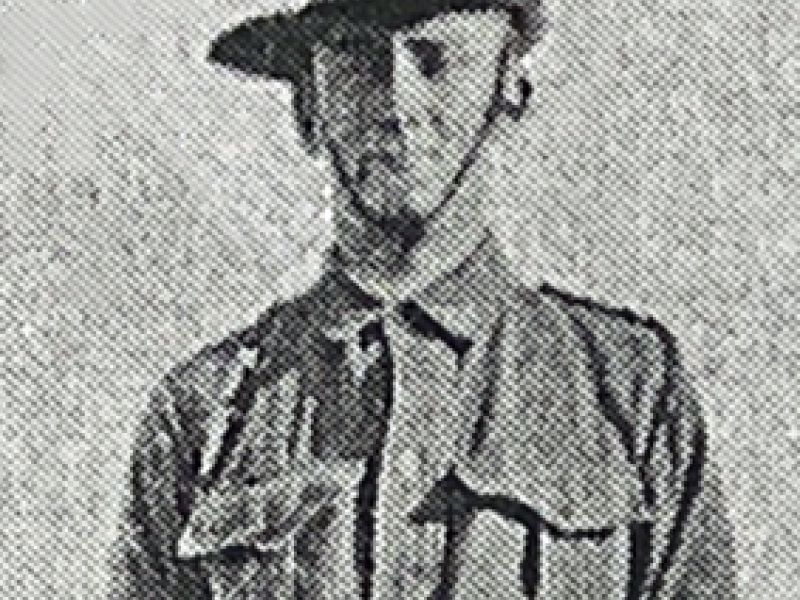John George Enever
John was born at Mitta Mitta in 1894, one of six children to John George and Jane Adeline (née Walker) Enever. Unfortunately, John junior never met one of his older brothers as he, Robert Walker Enever, died in 1890 when he was only three years-old. The family lived at Bogong View, Scrubby Creek. For their formal education the children attended the Mitta Mitta State School No. 887. On the farm they grew oats, wheat and barley which was sold to local farmers, while the chaff and oats were supplied to the Mitta Mitta Police Station for the horses.
John’s father passed away in May of 1915. John senior had been ill for some time, having been admitted into Nurse Dempsey’s private hospital about a month before his death.
On the 14th of February, 1916, John took, and signed, the oath taken by all enlisting in the 1st AIF. His service records indicate that was done at Eskdale, in northern Victoria. He was allocated the Regimental Number 578 and placed in B Company of the 37th Battalion. The battalion was formed as part of the 10th Brigade of the 3rd Australian Division. Its recruits were drawn from Melbourne, north-east Victoria and Gippsland and underwent their initial training at Seymour in Victoria. On the 10th of May he was charged with having been absent without leave for a period of two days. His unofficial vacation cost him 10/-.
Prior to leaving for overseas, John made provision for his mother and two brothers, Thomas and Neal, to be awarded equal shares in his estate. The battalion sailed from Melbourne on the 3rd of June 1916 aboard HMAT A34 Persic, disembarking at Plymouth in the south of England approximately eight weeks later. They entrained at 1800 hours on the 25th of July and arrived at No. 5 Camp, Lark Hill at 0215 hours the following day. The next few months were spent training for the conditions and style of warfare that they would experience at the Western Front. In late November they deployed to France occupying trenches in the Armentieres sector.
Conditions in the trenches were freezing, Europe experiencing their coldest winter in many years. Christmas day was celebrated by sending over a small and silent raid in enemy trenches in front of them. There was certainly no fraternising with the Germans as had been the case during the first Christmas spent at war in 1914.
In mid January of 1917, the battalion had moved to the Steenwerk sector, some ten kilometres east of Armentieres. On the 28th of that month, the gun positions near battalion headquarters were heavily shelled, with two guns being destroyed. The battalion itself suffered only one casualty - John. He was wounded by shrapnel in the right arm and sent back to the 10th Australian Field Ambulance. He was eventually evacuated to England for treatment at Beaufort Hospital. A lengthy convalescence followed after which John was transferred to the 67th Battalion, part of the newly raised and soon to be dismantled 6th Division. His training continued at Windmill Hill in England. In late August the division was broken up and its men distributed to reinforce existing battalions overseas. John crossed to France to reinforce the 37th Battalion and returned to his old unit on the 1st of September 1917. The 37th Battalion were in Belgium, training for the new offensive about to open at Ypres.
The 37th Battalion was designated to be part of the attack on Broodseinde Ridge. This feature provided German observers and gunners with an uninterrupted view of the Allied armies around Ypres. On the 4th of October 1917, the battalion led the 10th Brigade in the assault on the ridge. It advanced under a formidable barrage to seize the first objective near Judah House, in front of Tyne Cot, where it dug in before being leapfrogged by the 38th Battalion. It was during this period that John was killed. There is no report of how he died or of any subsequent burial.
John has no known grave. He is remembered on the Australian War Memorial Roll of Honour, the Menin Gate Memorial in Ypres, Flanders, Belgium, and the Mitta Mitta State School No. 887 Honor Roll. For his service during the First World War, he was awarded the British War Medal and the Victory Medal.

 Stephen Learmonth
Stephen Learmonth